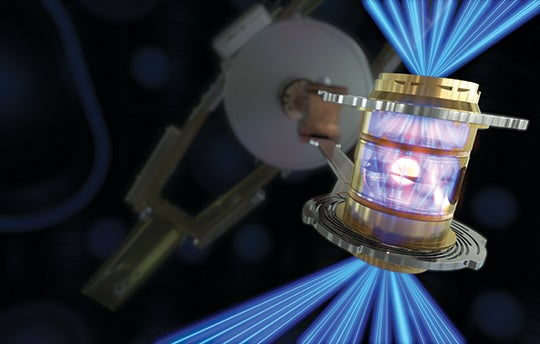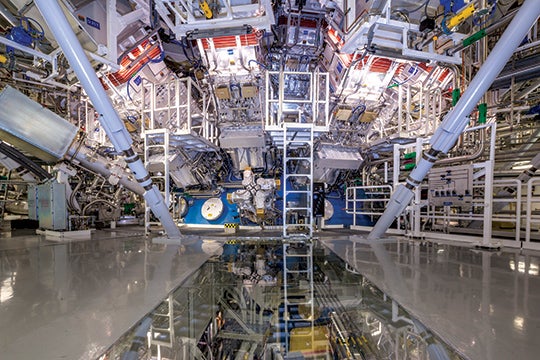Fusion Futures
Alumnus Robert Plummer works to advance fusion ignition for a sustainable clean energy future.

Summer 2023
By Jenny West Rozelle '00
If you’ve seen the movie “Star Trek Into Darkness,” then you may have seen a huge futuristic facility full of intricate systems: the workplace of Robert Plummer ’08. The real-life Lawrence Livermore National Laboratory’s National Ignition Facility is where Plummer has spent much of the past 13 years of his professional career. “You should never watch that movie with someone at [our facility],” says Plummer. “We’ll pause it to say, ‘I built that!’ or ‘I know what that is!’”
Plummer’s workplace may have been the setting for a science fiction movie, but the work they do there aims to turn fantasy into reality. On Dec. 5, 2022, scientists achieved fusion ignition in a laboratory — producing 50% more energy from fusion than was delivered to the target. “For the first time, humankind has demonstrated net energy gain from nuclear fusion in a controlled laboratory environment, so it’s huge,” says Plummer.
Both fusion and fission yield vast amounts of energy; however, fission produces highly radioactive byproducts when uranium and plutonium are split into smaller atoms, whereas fusion — which powers our sun and other stars — delivers a much cleaner version of energy that is also several times more powerful.
The National Ignition Facility’s successful fusion ignition was accomplished in a building the size of three football fields with the world’s largest and most energetic laser system. To create fusion at their facility, a low-energy pulse is amplified on the order of a quadrillion times, creating 192 laser beams that travel to the target chamber, a journey of about 1,500 meters, in about five microseconds. The lasers are then focused on a gold cylinder about the size of a pencil eraser with a peppercorn-sized pellet of hydrogen fuel inside. The lasers hit the inner wall of the gold cylinder and generate X-rays that compress the hydrogen, releasing huge amounts of energy.
On Dec. 5, 2022, scientists achieved fusion ignition in a laboratory — producing 50% more energy from fusion than was delivered to the target.
Although using fusion commercially to power homes is still many years in the future, it would provide sustainable energy with none of the greenhouse gases created by traditional fossil fuels. “I’m confident we’ll repeat ignition with increasing frequency over the coming years,” Plummer continues. “[We] just had our Kitty Hawk moment. This is that level of impact.”
Kim Budil, director of Lawrence Livermore Lab, adds, “The pursuit of fusion ignition in the laboratory is one of the most significant scientific challenges ever tackled by humanity, and achieving it is a triumph of science, engineering and, most of all, people.”

While one of the facility’s missions is to support inertial fusion energy for a sustainable clean energy future, the facility’s primary mission is to help maintain the reliability and safety of the U.S. nuclear weapons deterrence program without nuclear testing. Plummer, who describes himself as a pacifist at heart, says, “I never liked the idea of nuclear weapons, but I’ve come to understand that nuclear weapons are the greatest deterrent we have. It’s much better to be at the forefront of understanding how they work and focusing on things like nonproliferation and counterterrorism, so I have a great respect for why what we’re doing matters.”
Plummer began working at the National Ignition Facility in 2010 as a mechanical engineer, designing and providing engineering support for the positioning and delivery systems inside and around the chamber, before being promoted to head of engineering and maintenance for the facility’s optics organization. As the engineering manager, he oversaw a team of 30 people and was in charge of all the equipment that is used to process the optics. In 2021, Plummer accepted the job of chief engineer of Advanced Photon Technologies.
The laser currently fires only a little more than one time per day on average; a lot of electrical energy is required to excite it, and the recharging process takes time. Reaching the commercial prototype phase will require a large amount of time and research. “We have to have advances in the laser technology, which is what I’m working on,” Plummer says, “so that we can fire many times a second at these really high energies and powers. We need to make it robust, reliable and resilient.” The research and development work being done at Advanced Photon Technologies will help make a prototype inertial fusion power plant possible.

Plummer, who was born in Norway and moved to Houston when he was 7 years old, says that he has always been an engineer at heart. “Building with Legos as a kid — that’s just who I am.” The high school Texas All-State clarinetist also has a passion for music and decided to apply early decision at Rice because of the university’s strong engineering and music programs. He majored in civil and environmental engineering while finding time to take private composition lessons at the Shepherd School of Music. Plummer, who was also president of Brown College his senior year, next attended Stanford University to earn his master’s degree in structural engineering and geomechanics. He’s very happy with where he’s settled.
“I really love where I work,” Plummer says. “The [Lawrence Livermore] Lab is one of the best employers anyone could wish for. It’s because of the people. They’re super smart — it’s a lot like Rice in that sense.”
He is also enthusiastic about what the future holds. “I’m very excited about helping make a prototype commercial fusion power plant a reality,” he says. “That’s hugely inspiring. To be a part of the leadership team that could maybe demonstrate it within our lifetime — what more could you ask for?”
